More people are starting their small backyard farms with the prevalence of hormones in our meat and vegetable foods at the supermarket.
Many people start by growing a selection of vegetables, but they lack the protein only meat can provide.
Some people have started raising their chickens to fill this dietary gap.
Chickens are small, low-maintenance animals, and a chicken coop will easily fit in most backyards.
Not only are chickens an excellent source of meat, but some breeds are also prolific egg layers.
There are many different chicken breeds available, and some of them are prized for their meat more than others.
To help you decide which chickens you might want to raise on your small farm, we have compiled a list of the 18 best meat chicken breeds.
Table of Contents
ToggleTable of the Best Meat Chicken Breeds
The table below shows the best breeds of meat chickens and their weight and time until harvest for an easy reference, followed by a list providing more details about each breed.
| Chicken Breed | Average Weight | Time Until Harvest |
|---|---|---|
| Cornish Cross | 8-12 lbs. | 6-8 weeks |
| Bresse | 5-7 lbs. | 16-20 weeks |
| Jersey Giant | 11-13 lbs. | 16-21 weeks |
| Freedom Rangers | 5-6 lbs. | 9-11 weeks |
| Orpington | 8-10 lbs. | 18-24 weeks |
| Brown Leghorn | 5-6 lbs. | 16-21 weeks |
| Turken | 4-6 lbs. | 11-18 weeks |
| Egyptian Fayoumi | 4-5 lbs. | 14-18 weeks |
| Chantecler | 7-9 lbs. | 11-16 weeks |
| Buckeye | 6.5-9 lbs. | 16-21 weeks |
| Delaware | 8.5 lbs. | 12 weeks |
| Croad Langshan | 9 lbs. | 14-18 weeks |
| Dorking | 9 lbs. | 16-20 weeks |
| New Hampshire Red | 8.5 lbs. | 8-10 weeks |
| Kosher King | 5 lbs. | 12 weeks |
| Plymouth Rock | 7-8 lbs. | 8-12 weeks |
| Wyandottes | 8 lbs. | 16 weeks |
| Rhode Island Red | 7-8 lbs. | 12-16 weeks |
Cornish Cross

The Cornish Cross chicken is a breed of Broiler chicken.
Broiler chickens are bred specifically for their meat.
Female Cornish Cross chickens weigh up to 8 pounds, while males will grow up to 12 pounds.
Due to their inactive lifestyle, these chickens reach their ideal weight in just 6 to 8 weeks.
The Cornish Cross is known as the best breed of chicken for breast meat due to its quick growth rate and good flavor, and many commercial chicken producers also use it.
The Cornish Cross has yellow skin, turning a golden color when cooked.
Since they grow so quickly, these chickens eat a lot of food compared to other breeds.
They must be slaughtered as soon as they reach the proper weight, or they will continue to get larger and suffer from health issues like broken legs or heart problems.
These chickens rarely breed because they become too large by reaching sexual maturity.
Bresse
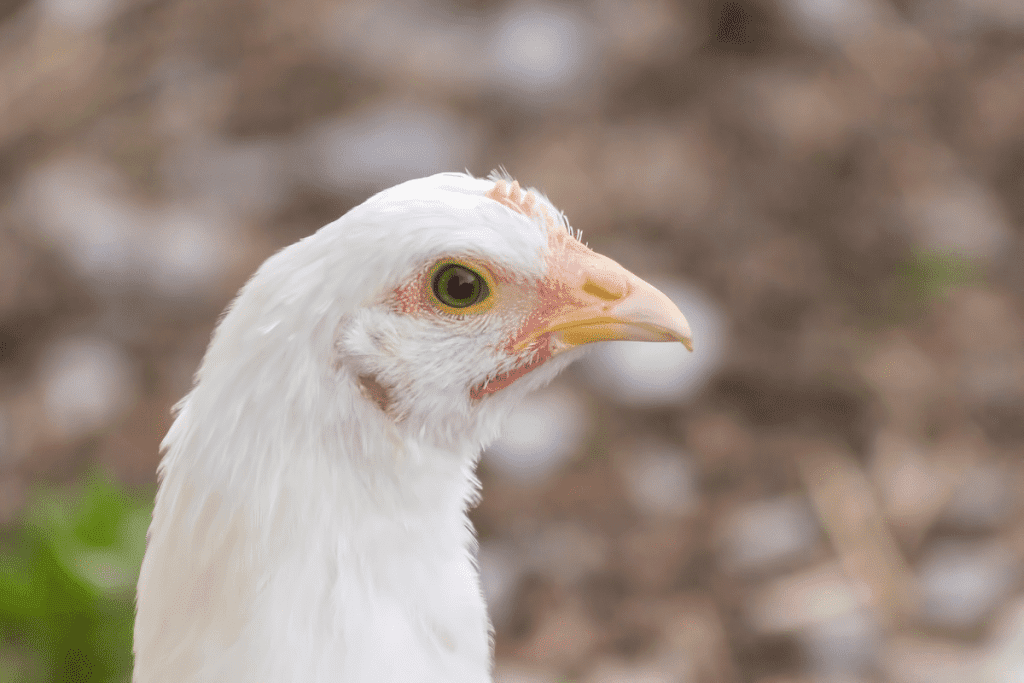
The Bresse chicken is another type of Broiler chicken.
Bresses are usually white, but they also come in blue, gray, and black.
Their feet are blue, which makes them popular and thus more expensive.
You may offset their high cost by growing their food and feeding them nutritious table scraps such as watermelon rinds, strawberries, and lettuce.
Females weigh up to 5 pounds, and males will grow up to 7 pounds.
Bresse chickens are usually ready for harvest between 16 to 20 weeks.
The Bresse chicken is known to have the best-tasting meat, and it is very tender.
However, the meat yield is relatively low compared to other Broiler breeds due to their small size.
The American Poultry Association does not accept them, but they are still popular due to their excellent flavor.
Unlike the Cornish Cross, the Bresse is easy to breed, so you will quickly recover the initial expense of ownership.
Jersey Giant
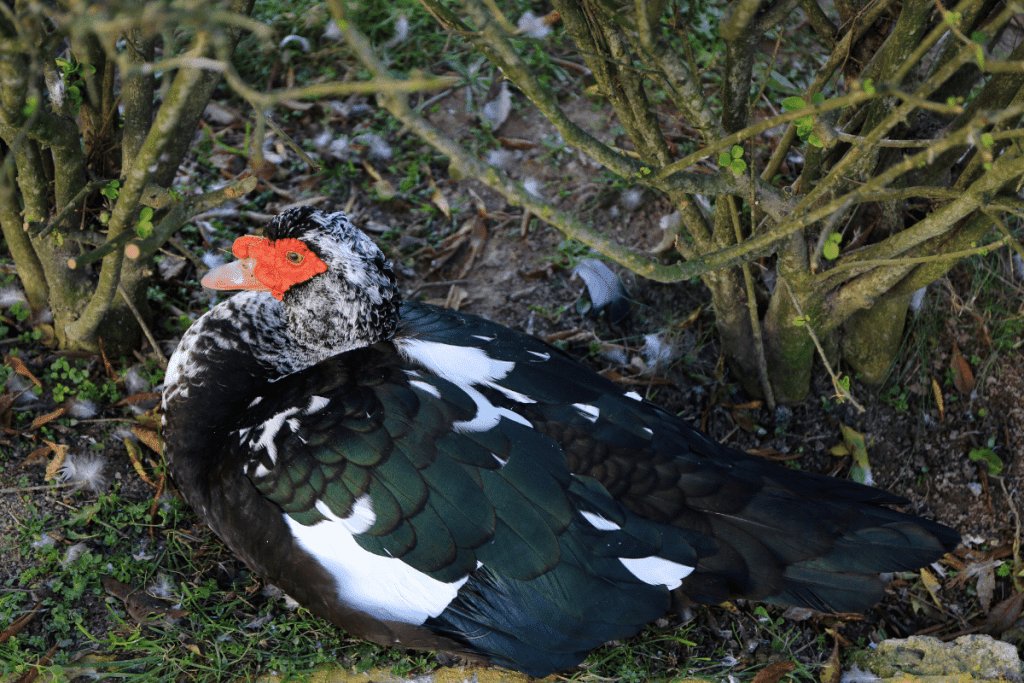
The Jersey Giant chicken was initially bred in the United States to replace the turkey.
While the turkey was never replaced, the Jersey Giant remained a popular Broiler breed due to its delicious flavor.
This breed comes in white, blue, or black.
The Jersey giant is a large bird, growing between 11 and 13 pounds, but it takes anywhere from 16 to 21 weeks before they grow large enough to harvest.
This breed eats a lot because of its large size, but you may again offset this expense by growing the chicken food.
Most commercial operations shy away from the Jersey Giant because of its expensive diet and slow growth rate, but they work well in small backyard farms.
The hens lay very large brown eggs, so you will be able to get those while you wait for the chicken to mature.
Jersey Giants also do not suffer from the same health problems as Cornish Crosses.
Additional learning: Jersey Giant Chicken Eggs: Guide And FAQ
Freedom Rangers
Freedom Rangers were originally bred to be pasture-fed meat chicken and produced for the pesticide-free meat market.
These chickens thrive on a low-protein diet, and they easily roam around large areas.
Freedom Rangers are less expensive to raise than other chicken breeds, and their diet consists mainly of corn feed and field bugs.
Related: Do chickens eat fire ants?
These chickens are usually different shades of red, but they also come in gray and bronze.
They may also have spots, black feathers, or bar markings.
Freedom Rangers tend to be smaller chickens, with females weighing about 5 pounds and males weighing 6 pounds.
It usually takes between 9 and 11 weeks to reach their mature weight.
These chickens are known for their flavorful and tender meat.
Orpington
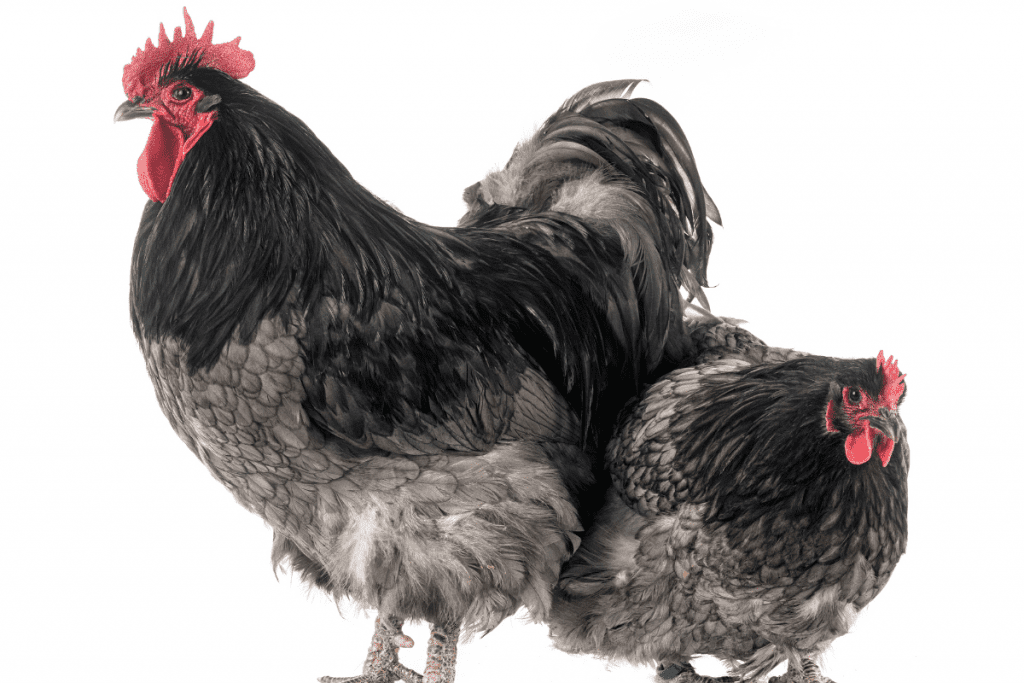
The Orpington is a heavy chicken breed, and it may be buff, white, blue, black, or lavender.
These chickens are known as a dual-purpose breed since they are also prolific egg layers and being raised for their tasty meat.
Female Orpingtons will weigh up to 8 pounds, and the males will weigh 10 pounds.
They grow at a slower rate, taking 18 to 24 weeks to reach maturity, but they can lay close to 200 eggs in one year.
The meat of the Orpington is tender and considered to have delicious meat.
Orpingtons are a heritage breed, and they tend to have a broad body, a short back, and a curved shape along the underside.
Related: Orpington Chicken Egg Guide
Brown Leghorn
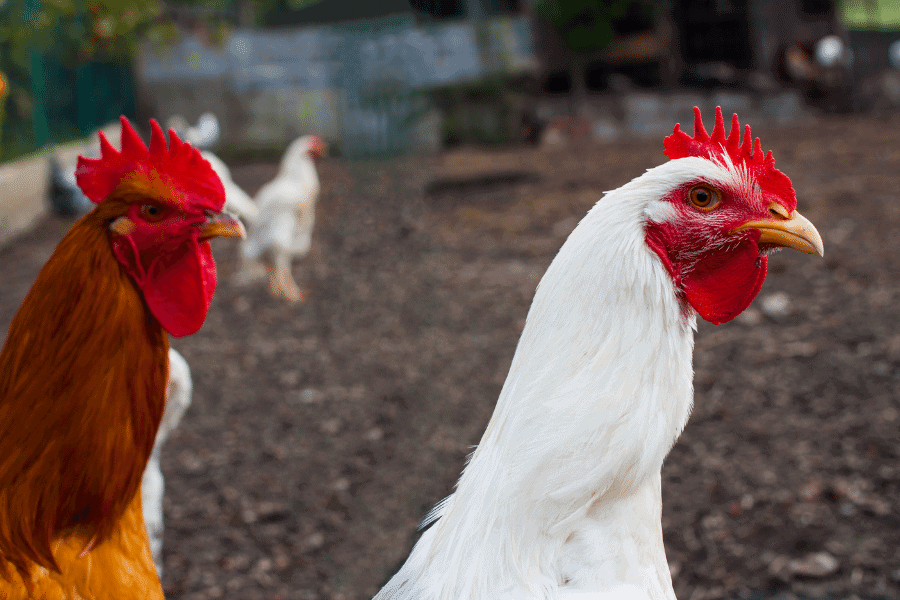
The Leghorn breed of chicken is available in various colors, including single comb, rose comb, white, red, black, brown, and buff.
The Brown Leghorn is another dual-purpose chicken, and it is capable of laying up to 280 eggs per year.
This breed is an avid forager, and it thrives in hot climates.
Males may become territorial, but they are usually not aggressive.
Brown Leghorn females weigh 5 pounds, while the males are only slightly larger at 6 pounds.
These chickens take 16 to 21 weeks to be ready for slaughter, but you will be able to get eggs from them in the meantime.
Further reading: Raising leghorn chickens for meat
Turken
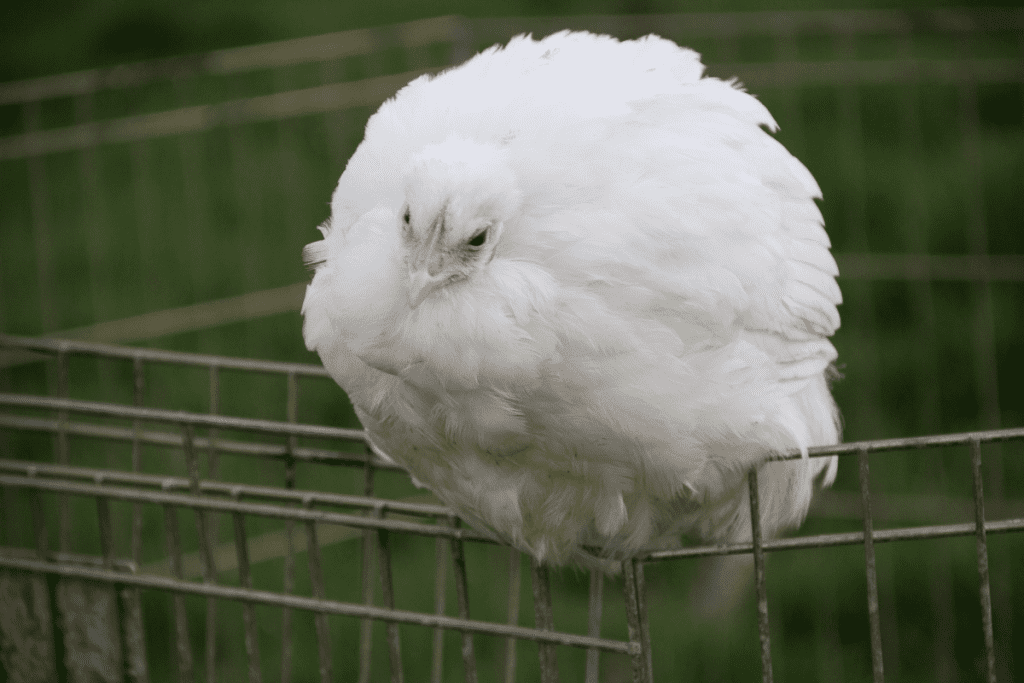
The Turken, also known as “The Naked Neck,” is an unusual-looking breed of chicken.
There are no feathers on its neck, so it resembles a turkey, which is how this chicken got its name.
Their color is typically brown and cream, but they may also be black, red, blue buff, or white.
These chickens have adapted themselves to hot and cold weather, so it is possible to raise them practically anywhere.
Female Turkens weigh about 4 pounds, while males weigh closer to 6 pounds.
It takes between 11 and 18 weeks before the Turken is ready for harvest.
These chickens are also capable of laying a little more than 100 eggs in a year.
Egyptian Fayoumi
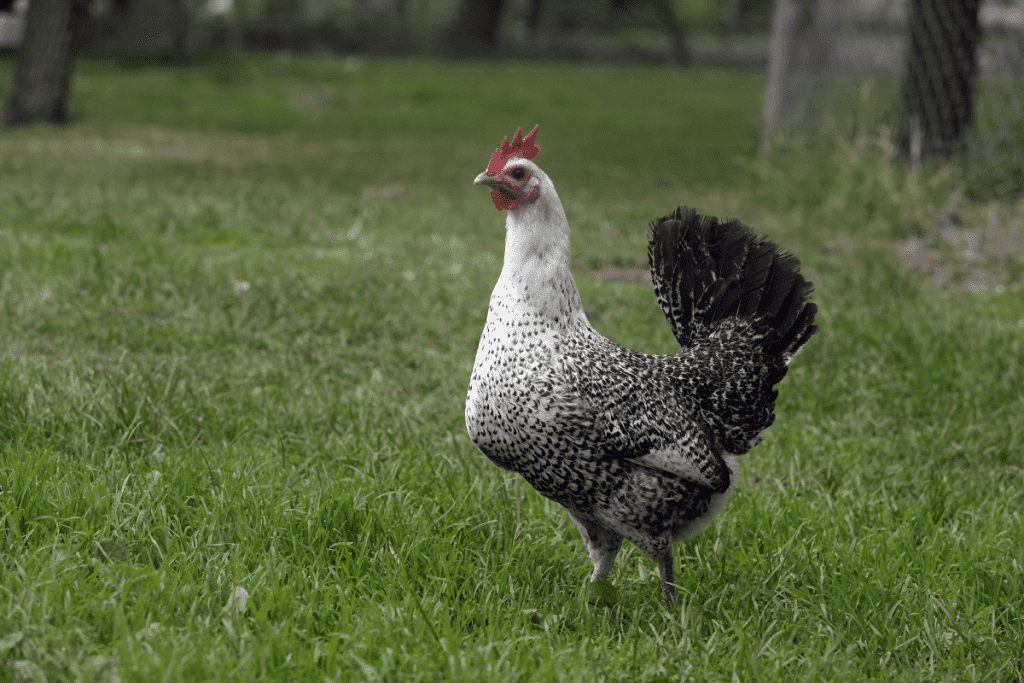
The Egyptian Fayoumi chicken thrives in hot climates and is a very active forager.
These chickens are ordinarily white with black speckles, but they may also be silver.
The Egyptian Fayoumi breed is not aggressive, and it is very resistant to a variety of diseases.
Females are generally small, weighing in at just 4 pounds, and the males weigh closer to 5 pounds.
With these birds, it takes 14 to 18 weeks until harvest time, but they are also active layers, so you will be able to expect up to 150 eggs from them in one year.
Read more: Are Egyptian Fayoumi Roosters Aggressive?
Chantecler
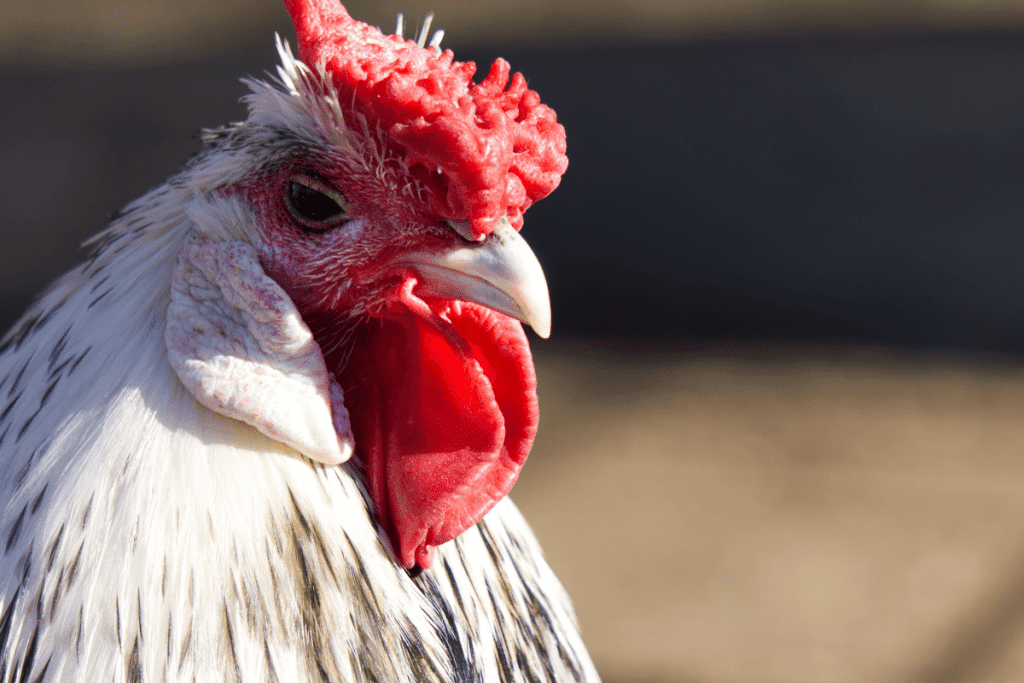
Chantecler chickens do exceptionally well in a cold climate, and their docile behavior makes them easy to raise.
The hens start laying eggs at a young age, and they are capable of laying up to 200 brown eggs in one year.
They are adept at foraging, which makes them good free-range chickens.
Females weigh around 7 pounds, and males weigh up to 9 pounds.
Chanteclers have a rapid growth rate compared to other chicken breeds, and they reach their harvest rate between 11 and 16 weeks.
Buckeye
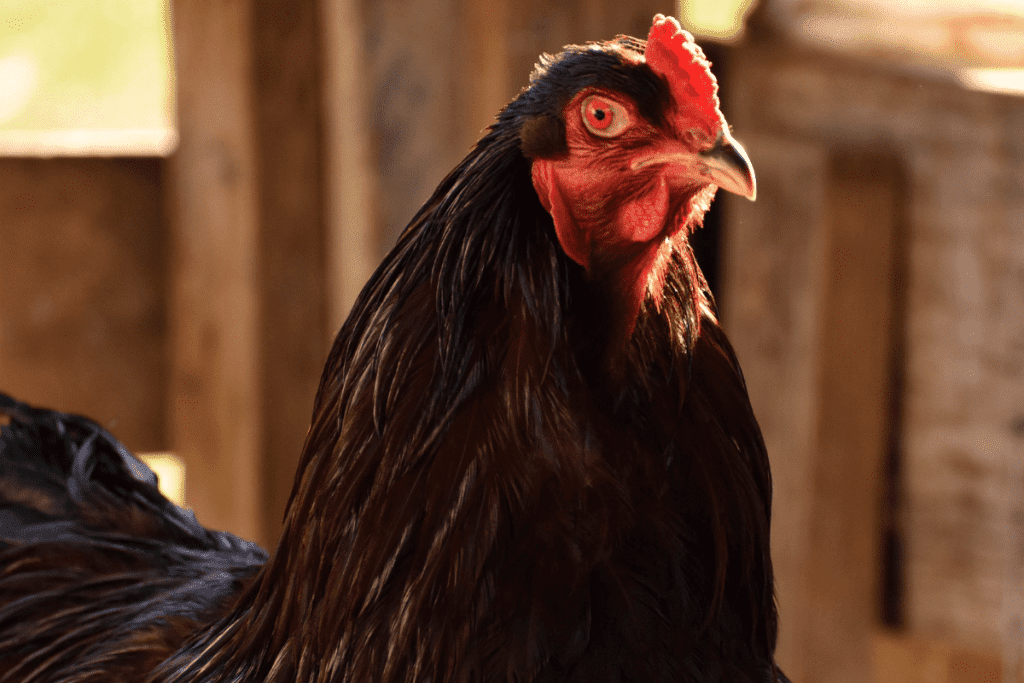
The Buckeye does very well in cold climates and is resistant to disease.
Many chicken populations dwindle during the winter months, so these chickens are an excellent choice for people living in the northeastern parts of the United States.
These normally docile chickens may become aggressive to cats and other small animals.
Buckeyes are a beautiful red color, and they tend to be on the smaller side.
Females usually weigh close to 6.5 pounds, and males weigh up to 9 pounds.
These chickens have a slower growth rate, and they do not reach full maturity until 16 to 21 weeks.
They are avid egg layers, though, and they can produce up to 200 eggs in one year.
Buckeyes are a great dual-purpose chicken breed, and they also produce tasty meat.
Related: How Long Do Buckeye Chickens Lay Eggs?
Delaware

Delaware chickens are a sizeable dual-purpose chicken breed, and while they are bred for their meat, they are avid egg layers capable of laying up to 280 eggs every year.
These chickens have a rapid growth rate, and they reach up to 9 pounds in 12 weeks.
The Delaware is a cross-breed between a New Hampshire Red and a Barred Plymouth Rock.
This was done to improve the meat quality of the two breeds while keeping their egg-laying abilities intact.
Croad Langshan

The Croad Langshan is a unique-looking chicken with soft blue or black feathers which are green underneath.
This chicken, originally from China, also has feathered legs, adding even more to its unique appearance.
Croad Langshan females weigh around 8 pounds, with the males reaching up to 10 pounds, and they reach their harvesting weight within 14 to 18 weeks.
These chickens grow very quickly, and they are known to be intelligent and quiet animals.
The dual-purpose birds are raised for their flavorful white meat, but they are also able to produce up to 200 eggs in one year.
This hardy heritage chicken breed was first bred in China in the 1800s, but the American Poultry Association recognized them in 1883.
Croad Langshan chickens can fly high enough to scale a fence, so they need an enclosure with a roof.
Dorking
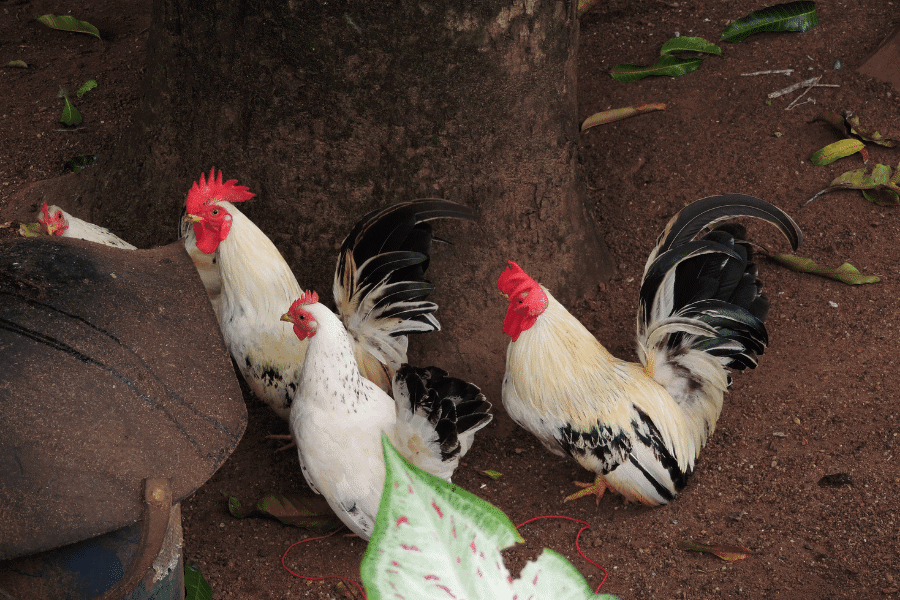
The Dorking chicken is named after an English town, and it is best known for its tender white meat.
They are also able to produce up to 140 large white eggs in one year, although the females do not begin laying eggs until they are almost six months old.
These chickens have a very calm temperament, and they need to be kept away from more aggressive chickens because they cannot defend themselves very well.
They prefer to forage their food, adapting well to most settings.
However, Dorkings are prone to frostbite, so they are not good for someone living in a cold climate.
Dorkings weigh approximately 9 pounds, reaching their harvest weight between 16 and 20 weeks.
New Hampshire Red
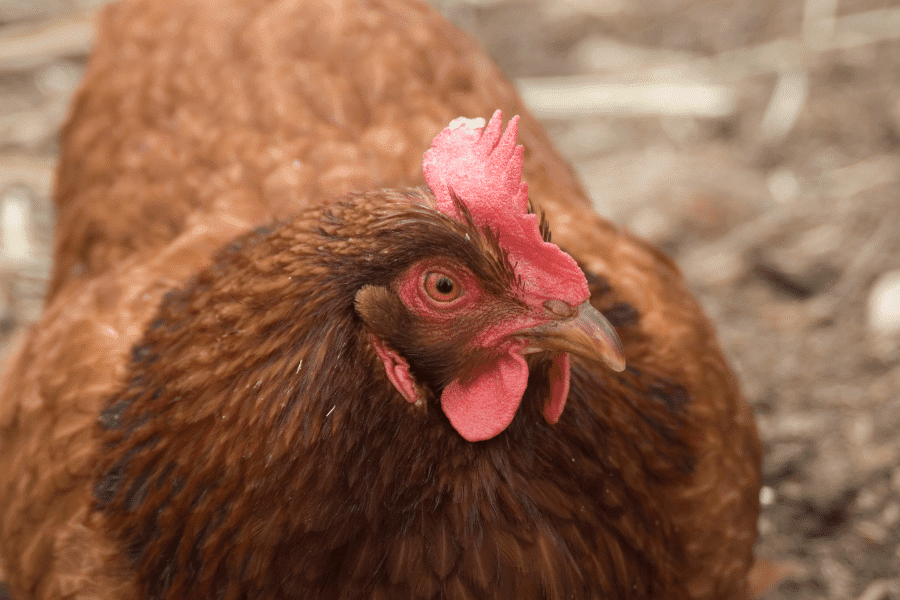
The New Hampshire Red is an American dual-purpose bird capable of producing large quantities of eggs in addition to its tasty meat.
Even though they are avid egg producers, they are also classified as Broilers due to their rapid growth.
These chickens will reach their harvest weight of 8.5 pounds in only 8 to 10 weeks.
New Hampshire Reds are usually docile chickens, but the males may become aggressive at times.
These birds are excellent for people living in colder areas because they can tolerate cold climates and harsh conditions.
Kosher King
Kosher Kings are beautiful chickens with black and white striped feathers.
The males tend to grow faster than the females, but on average, these birds reach their harvest weight of 5 pounds in about 12 weeks.
The females are also excellent egg-layers.
Because they are bred from heritage breeds, Kosher Kings may be difficult to find.
Their faster maturity rate sets them apart from other heritage breeds of meat chickens.
Plymouth Rock

The Plymouth Rock chicken got its name because it was one of the first breeds of chicken raised in America.
They used to be difficult to find, but there are more available now due to a recent surge in popularity.
Plymouth Rock chickens are favored for both their egg and meat production.
They became a foundation breed for many broiler chickens found in today’s commercial chicken industry.
These chickens usually weigh 7 to 8 pounds, and they quickly reach their harvest weight in just 8-12 weeks.
Wyandottes
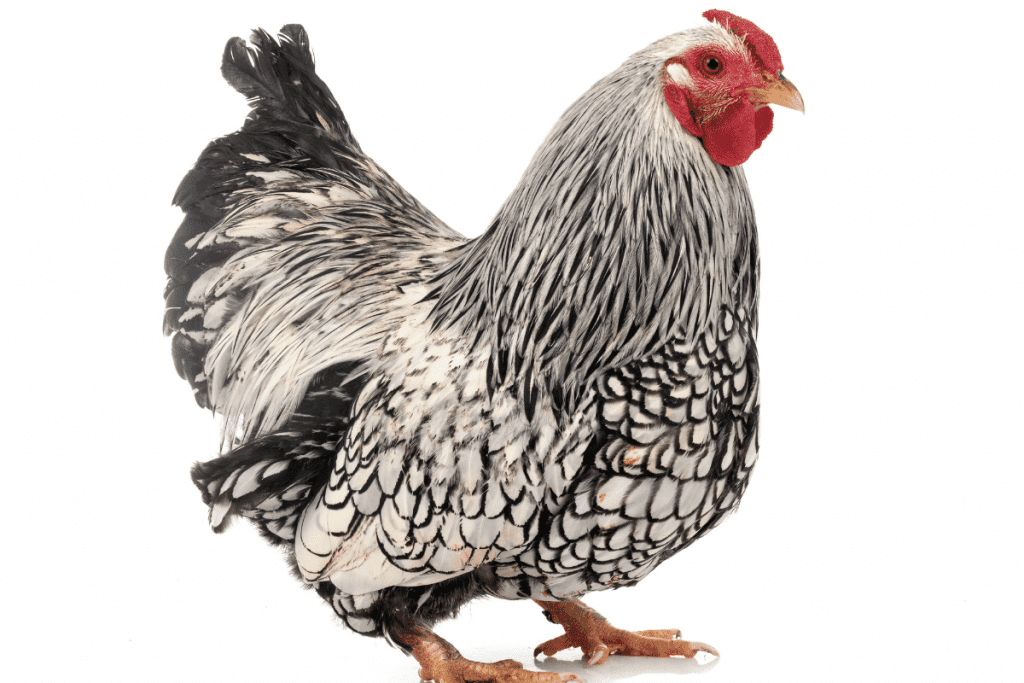
Look no further than the Wyandottes if you are looking for a chicken with a truly striking appearance.
Their feather patterns include silver penciled, golden laced, Columbian, white, and blue.
These birds are very rare, but they have gained popularity among people who raise chickens in their backyard.
These chickens weigh around 8 pounds on average, and they reach their harvest maturity at 16 weeks.
Wyandottes are well-acclimated to cold temperatures, and they do not do well in warm climates.
Related: When do Wyandotte chickens start laying eggs?
Rhode Island Red

The Rhode Island Red has been used to create many different hybrid breeds of chickens.
These chickens were produced as dual-purpose chickens, and they will lay up to five extra-large brown eggs per week.
The average size of a Rhode Island Red is 7 to 8 pounds, and they reach their harvest maturity within 12 to 16 weeks.
These birds do well in cold weather but not heat.
Rhode Island Reds are docile birds, and they prefer to forage for their food in a free-range environment.
Generally, these chickens are very calm and easy-going, but males tend to become aggressive.
Commonly Asked Questions
Are there physical differences in meat-producing chickens versus egg-laying chickens?
Meat chickens, also known as Broilers, are bulkier and contain more muscle tone, producing tender meat.
They are mainly bred for producing large breast meat.
Broiler chickens may also be male or female, while egg-layers are only female.
Female Broiler chickens are also capable of producing eggs, but they do so at a much slower rate than an egg-laying hen because they simply are not bred for egg production.
Broiler chickens also have a different diet than egg-laying chickens.
If the egg-laying hens ate the same feed as the Broilers, they would become too large to lay eggs successfully.
How do you properly fatten up meat chickens?
It is essential to feed your Broiler chickens the right diet, even if they are dual-purpose birds.
If they are not properly fed, they may get too big or not big enough.
The chickens need to be fed on the 12/12 schedule to ensure they get the correct fat-to-meat ratio.
The 12/12 schedule involves having the food available for 12 hours of the day and removing it for the other 12 hours.
Water should always be available, but it needs to be on the opposite side of the food.
Keeping the water and food separated ensures the chickens will have to walk just far enough to build muscles.
Otherwise, the chickens would become very obese because they would not move very much.
If the chickens begin to overeat, their meat will taste differently, and it will not be as moist and tender.
Can you raise meat birds from day-old chicks?
Besides their diet, raising meat birds from young chicks is no different from raising egg-layers.
Chicks are usually purchased from a hatchery or a feed store.
The main difference in purchasing chicks for meat production is you do not have to worry about the sex of the animal.
Most meat chickens are harvested before they reach sexual maturity.
This usually means you will get meat chicks at a lower cost because they do not have to be sexed first.
How do you house your meat birds?
Meat birds will need a chicken coop as the egg-laying chickens use.
The main difference is the size of the coop.
The coop will have to be larger because you will usually be raising more meat chickens than egg-laying chickens at any given time.
You may be raising 50 to 200 chickens in one year to meet your family’s needs.
One advantage of raising meat chickens is you will not need an insulated coop to protect them from cold weather since you will not be keeping the chickens for an entire year.
A meat chicken coop is much easier to build and maintain because you do not need to create nesting boxes or roosts.
When are meat birds ready to eat?
The time it takes for a meat chicken to reach its harvest weight will vary according to the breed.
While some meat chickens will be ready for slaughter in just six weeks, other breeds may not be ready until 21 weeks.
Other birds may continue to grow after their maturation date, but it is usually more economical to harvest them slightly smaller.
You may either choose to process your chickens on your farm or take them to a slaughterhouse to be butchered.
The fees at a slaughterhouse tend to be relatively high, so most people choose to save money by butchering their chickens on their farm.
However, if you plan to sell your meat chickens, they will have to be slaughtered at a USDA-inspected facility.
Read next: Are Brahma chickens good for meat?
How useful was this post?
Click on a star to rate it!
We are sorry that this post was not useful for you!
Let us improve this post!
Tell us how we can improve this post?
